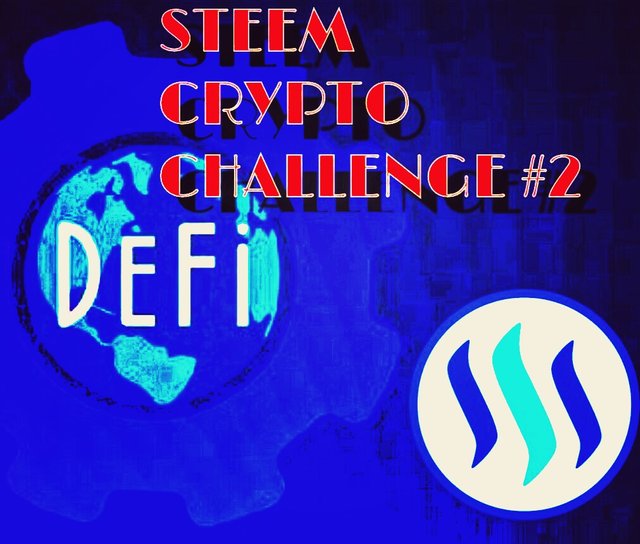STEEM CRYPTO CHALLENGE: DeFi Proof of Stake and DeFi Building Blocks
Welcome again to today on DeFi. Today, we are going to be looking at proof of stake and DeFi building blocks.

Proof-of-Stake(PoS) Algorithm
This is a mining algorithm that enable holders of assets within the blockchain to earn rewards for holding. It is employed by DefI to improve upon the Proof-of-Work (PoW) being used by the Bitcoin core.
Under Proof-of-Stake, investors can buy assets, stake it in the blockchain to generate dividends. This is similar to the fixed deposits in the banking system, but here the blockchain is coded to enable individual carry out staking or withdrawal at any time stipulated by the code of choice.
It is both transparent and decentralized, thus no third party is needed to monitor it or stop an investor from staking.
Stakes can be modified through the use of stake modifier in the blockchain, which is a collective source of random entropy. The modifier prevents the prediction of the PoS kernel.
Stake Protection
A staker can sign as many conflicting blocks as he wants in the PoS blockchain. Thus, there’s no stake protection in the DeFi blockchain. Every possible branch or fork in PoS can be staked for by stakers, which weakens the finality of the PoS based blockchain.
This is known as a double sign and is impossible in the PoW blockchain run by Bitcoin. In PoW a miner can’t mine all available branches without having to split mining capacities in the process.
Thus, to ensure the finality of DeFi blockchain, there must be a way to economically penalize double-signs and this is done through explicit mechanism.
How can a double-sign be detected?
In the DeFi blockchain, each block header is assigned number sequence. If a staker uses the same number sequence for multiple blocks, it means he is double-signing.
Penalty for double-signing
If a staker double-sign, the DeFi blockchain immediately disallow immediate withdrawal for that particular staker. At the confirmation of deactivation transaction, the DeFi blockchain requires 3000 blocks to pass before withdrawal of stake.
DeFi Building Blocks
These are base native components in the DeFi blockchain. It includes:
DeFi Standard Token (DST)
DeFi Custom Token (DCT)
And
DeFi Asset Token (DAT)
Now the details:
DeFi Standard Token (DST)
This is a standard token in the DeFi blockchain that serve as a model for other assets to be brought into the DeFi blockchain.it employs trustless mannerism and trustless financial contracts for the trading of all major tokens in the DeFi blockchain.
DST allows the tokenization of other assets in the DeFi blockchain, thus the name DeFi Standard Token (DST).
DeFi Custom Token (DCT)
These are tokens that can be created by any uder to represent an individual project or set of smart contracts in the DeFi blockchain.
DCT are not backed by the DeFi blockchain, as they are revoked when the purpose of creating it is completed.
DCT have the following parameters:
DCT ID: Unique blockchain identifier for the token.
Name: Name of the tokens.
Tradeability: yes/no. This is a one-way switch allowing the token owner to transfer tokens during initial distribution period and also to decide when a token is tradeable/movable. To ensure the decentralized nature of DCT, once “tradeability” is set to yes, the owner is no longer able to reverse the tradability of a token.
Symbol: The ticker symbol for the tokens. The DCT protocol will provide a reference for ensuring the choice will be a unique symbol.
Decimal places: Divisible number of decimal places for the tokens. This cannot be changed once it is set.
Initial distribution list: List of addresses for distribution of tokens.
Minting support: yes/no
Total initial supply: Initial issue of tokens during the event generated.
Final supply limit (optional): Immutable total supply limit. If minting is supporting this will define the ceiling on how many tokens the token owner can mint in total (some may be reserved at this time). If this parameter is left blank, this is an unlimited supply token. This cannot be changed after the initial definition of the token.
Typically, when creating a token, this should be turned to “no” until the initial distribution is confirmed to be accurate.
DeFi Asset Token (DAT)
These are external tokens in the DeFi blockchain backed in a decentralized manner.
DATs are brought into the DeFi blockchain through voting with masternodes. The voting is done by the blockchain users. This ensures that only tokens with the best interest of users are being introduced into the DeFi blockchain.
Example of DATs are:
DXRP, back by XRP
DBTC, backed by BTC
DUSDT, backed by USDT
DETH, backed by ETH, among others.
That’s how much we can take for today. Please stay tuned for tomorrow entry, where I will be talking about loan contract, decentralized exchange (DEX) and cross-chain exchange (XCX).

Thank you:
@steemitblog
@steemcurator01
And
@steemcurator02
For all your support. Cheers to all steemians all over the world.
I love you all.
Shared on tweeter:
https://twitter.com/Georgedezent/status/1314059839618854912?s=20
Congratulations you are one of the winners of the Steem Crypto Challenge Month...
Thank you for taking part
The Steemit Team
Thank you very much. I'm so excited.
Cheers!
Steemit 1st Steps for New Users
https://steemit.com/hive-142140/@punicwax/steemit-1st-steps-for-new-users